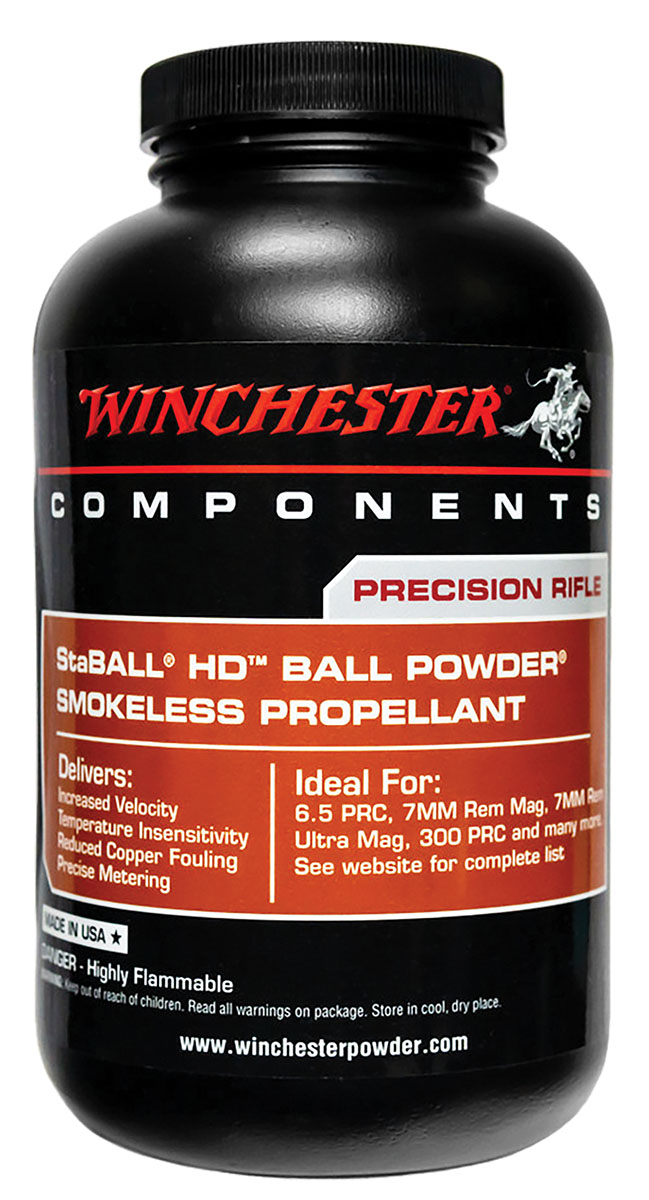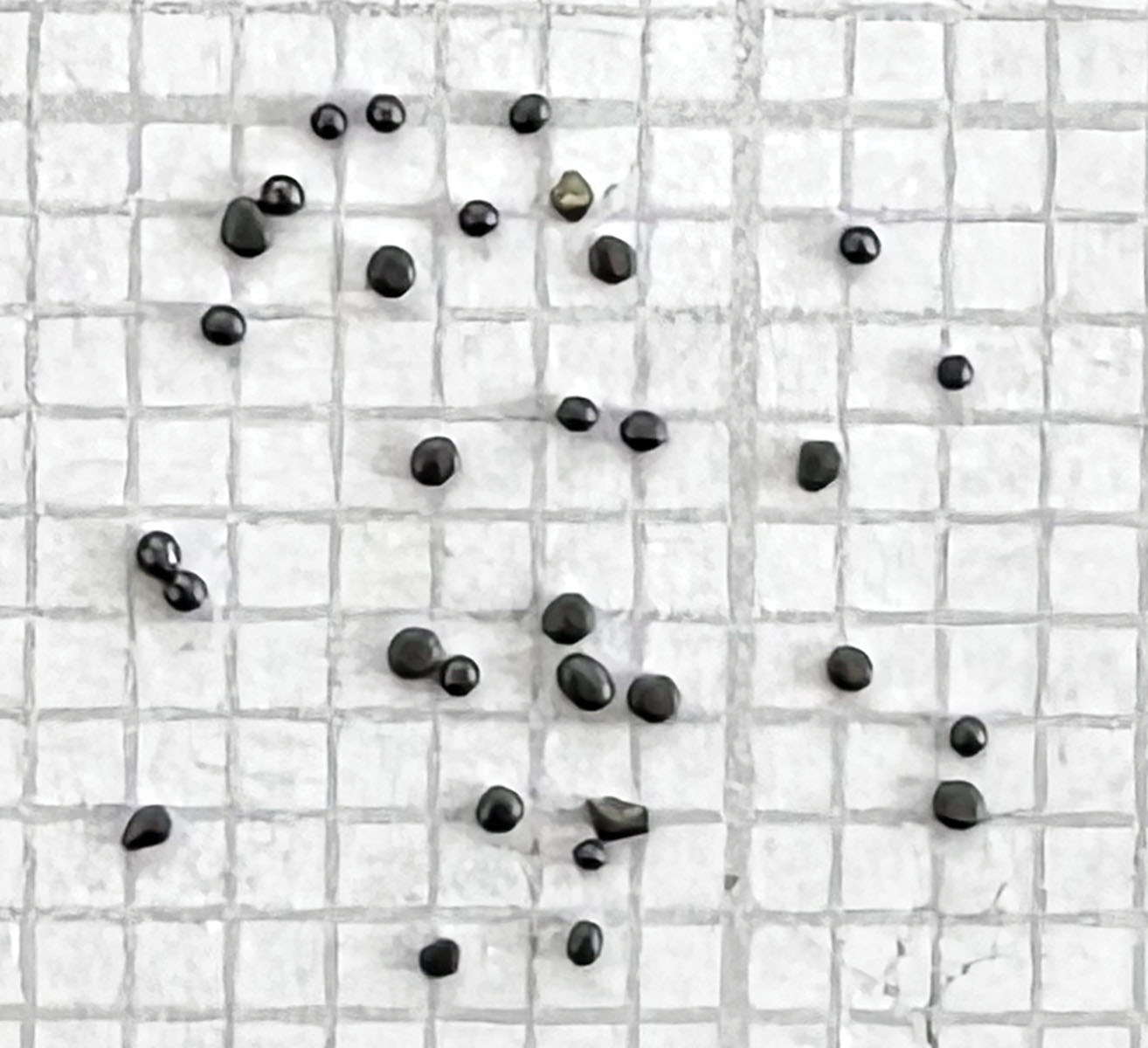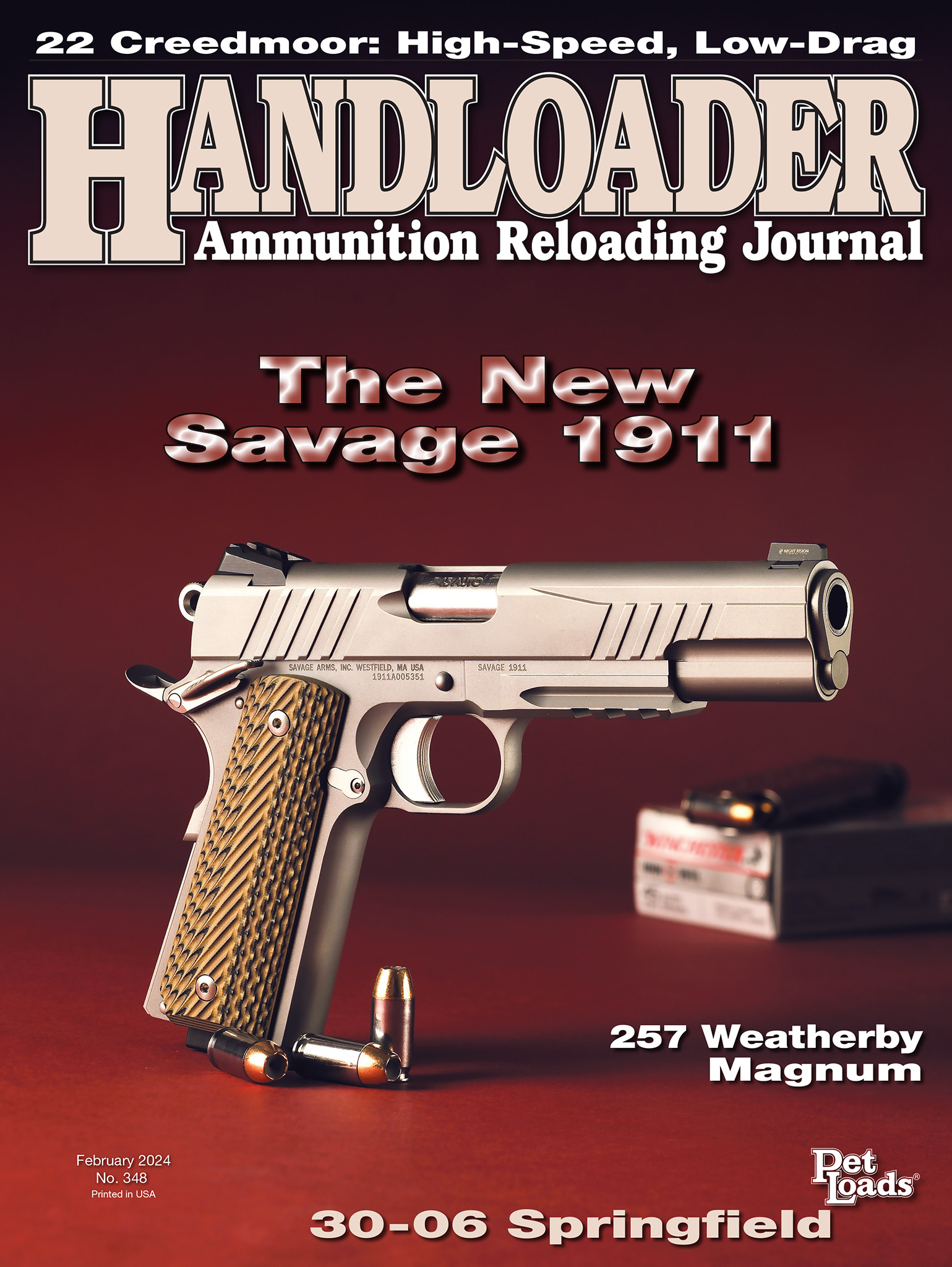Propellant Profiles
Winchester StaBall HD
column By: Randy Bimson | February, 24

Just to jog everyone’s memory, these two new StaBALL powders join their slightly more senior sibling, StaBALL 6.5, as the first three spherical powders to combine the chemical wizardry of the three “must have” attributes for handloaders of centerfire rifle cartridges. This is particularly true for those that in shooters’ vernacular are preceded with buzzwords like “high performance” and “precision rifle” and are considered very important in current propellants. Those attributes are the wonderfully consistent flow characteristics and high-load densities (when matched to appropriate cartridges) of most spherical-type powders, copper fouling reducing and copper removing agents, and temperature stability.
Given that no one propellant will work well with every cartridge and the practical useful application of propellants in particular cartridges often overlap to some degree, it is safe to say that the three Hodgdon Winchester-brand StaBALL series of powders proved to be extremely versatile.

Next up is StaBALL 6.5, which comes in at No. 126, just a little slower burning than time-proven propellants like the three-amigo 4350s, and Alliant’s Reloder 16 & 17, and these powders cover a huge range of 30-06-length cartridges, both non-belted and belted magnum configurations.
The focus of this edition’s column, StaBALL HD, sits at No. 152. This places StaBALL HD right in the midst of what is often described as the “slow-burning magnum” propellants, propellants like Alliant Reloder 26 (No. 148), Hodgdon H-1000 (No. 149), Ramshot Magnum (No. 150), Hodgdon RETUMBO (No. 151), IMR-8133 (No. 153), Ramshot LRT (No. 154) and Vihtavuori N570 (No. 155).
Like its sibling powders StaBALL 6.5 and StaBALL Match, StaBALL HD is produced at General Dynamics St. Marks powder works in Florida. As one might expect, at a glance, StaBALL HD is nearly indistinguishable from other Winchester Ball Powder propellants, being spherically-shaped granules that are a distinctive metallic grey/black color. The granules range in diameter from .0197 to .0394 inch. This is a good time to mention that very few “spherical” powders are truly spheres. More often than not, the granules appear as “miniature cow pies,” thick and kind of, sort of, round.
The propellant starts life as a sphere, but typical of St. Marks processes, it is put through a process called “rolling.” The spheres of propellant are passed through counter-rotating rollers that flatten the spheres.
So why if the granules start out as spheres are they “flattened?” Disregarding “deterrent additives” that are used to modify burn rates, the burn rate of a propellant is, to the greatest degree, determined by the propellant granules’ surface area. Essentially, what is being done is increasing the granules’ surface area by converting a sphere into a flake-type grain. This is one of the means used to increase the progressive burn rate and hence the “pressure-time curve” of the spherical propellant. Propellant pressure-time curves are defined by one of three categories, progressive burning, neutral burning, or regressive burning.
Progressive burning is when more surface area of the propellant granule ignites during its time in the barrel, producing more gas as the volume available to the powder charge expands with time and with distance the projectile travels, inside the barrel. This is typical of the extruded stick-type propellant granules physical characteristics, length, dimpled, perforated (usually a single hole running the length of the granule).
Neutral burning is when the burning area changes very slowly over the dwell time the projectile is in the barrel which results in a constant thrust over the burning period.
Regressive burning, the nature of spherical powders, is where the surface area decreases (the circumference of the sphere gets smaller) during the burn time the projectile travels down the barrel, and so does the pressure/thrust decrease as well. Typically, when compared to a progressive or neutral-burning propellant, the chamber pressure created by a regressive burning propellant will peak milliseconds sooner than progressive burning propellant because, as the burning area of spherical granules decreases, the gas production lowers, so the maximum pressure occurs sooner.
StaBALL is a double-base propellant with a nitroglycerin content of a nominal 10.75 percent. The nitroglycerin is an important part of the deterrent component of StaBALL HD. Unlike extruded propellants where the deterrent is a surface coating applied to the granules, the deterrent used with StaBALL is impregnated into the granule and is not just a surface coating. By manipulating the geometry, the rolling process of the spheres and the chemistry, Hodgdon Powders/Winchester brand has positioned StaBALL HD in the category of a very progressively burning powder.
StaBALL HD’s high bulk density of 0.96 g/cc means that we are able to get more propellant into a given cartridge case (never to exceed reputable loading data!) compared to many of the similar class of extruded stick-type propellants. Combine that with the aforementioned decoppering agents and temperature stability and we have a great combination for enhanced performance in both internal and external ballistics.
Winchester Powder states that StaBALL HD is ideally suited for the 6.5 PRC, 7MM Remington Magnum, 7mm Remington Ultra Mag and the 300 PRC. As I looked through the Hodgdon 2023 Annual Reloading Manual and Wolfe Publishing’s online LoadData.com, I found a wealth of data available for other cartridges including the 264 Winchester Magnum, 26 Nosler, 6.8 Western, 27 Nosler, 7mm PRC, 28 Nosler, 300 Winchester Magnum, 30 Nosler, 300 Norma Magnum, 300 Weatherby Magnum, 300 Remington Ultra Magnum, 33 Nosler and of course, the 338 Lapua Magnum. I am sure that by the time this edition of Handloader hits the newsstands or is delivered to your mailbox, some of the more noticeable exclusions like the 338 Weatherby RPM and 338 Winchester Magnum will have data available and I hope to have some decent weather before the snow flies to see if StaBALL HD can on improve the sterling performance of my all-time favorite big-game cartridge, the 300 Holland and Holland Magnum.
In addition to sharing some of Winchester Powder’s load data included in the data table, I did some hands-on testing with StaBALL HD as well. I chose three somewhat similar cartridges that originated over the years from the house of Winchester/Browning, for all intents to see how far we have progressed over the past 65 years with today’s hot trend for “short-fat” cases. The first, the 264 Winchester Magnum introduced in 1958, the second in the line of Winchester’s then first-family of “short-belted magnum” cases. The test rifle chambered for the 264 Winchester Magnum is my personal pre-’64 Winchester Model 70 Westerner. The second, an industry friend’s 2002 Winchester “Classic Model 70” actioned Featherweight in 270 Winchester Short Magnum. The third, another industry loaner and the new kid on the block, the Browning X-Bolt Stalker Long Range chambered for the 6.8 Western. Interesting how Winchester Ammunition has resurrected the Westerner-ish name once again. My Westerner and the Browning X-Bolt both have factory 26-inch barrels while the Featherweight is a still reasonable-for-the-caliber 24-inch barrel. To help keep the playing field level, I used a fine Weaver T-series steel Micro-Trac16-power silhouette scope, that Cheryl Ackerman-Warring of Optical Services Company had worked her magic on and cleaned and blueprinted a few years ago, on all three rifles. The performance of the T-16 was superlative. How far have we progressed in 65 years? Take a look at the data table and decide for yourself. As good as performers as the Winchester Classic Model 70 and the Browning X-Bolt are, I don’t think I will be selling my 264 Winchester Magnum Model 70 Westerner anytime soon.
The tooling I used for loading the test rounds is as follows; the 264 Winchester Magnum dies were Forster Benchrest series, the 270 Winchester Short Magnum dies were an RCBS Full-Length set, and the 6.8 Western were a Redding three-die Master Hunter set. The 264 Winchester Magnum and the 6.8 Western was loaded on my long-time favorite bench press, a Bonanza-Forster Co-Ax press and the 270 Winchester Short Magnum dies were set up in another favorite, the RCBS “Big Max” press. Total indicator runout for all ammunition loaded for the three cartridges did not exceed .0015 inch as measured on an RCBS CaseMaster gauge with the V-blocks retrofitted with hardened steel ball insert contact surfaces. All powder charges were thrown from a Neil Jones Custom Products powder measure with the charge weights verified using a tunned Redding No. 2 scale.
With all the attributes that the made-in-USA Winchester StaBALL line of propellants deliver that contribute to enhanced ballistic performance and match-grade accuracy, if you load for a cartridge that benefits from slower-progressively burning powders, StaBALL HD definitely needs to be on your must-have shopping list. StaBALL HD is available in 1- and 8-pound canisters.
.jpg)


